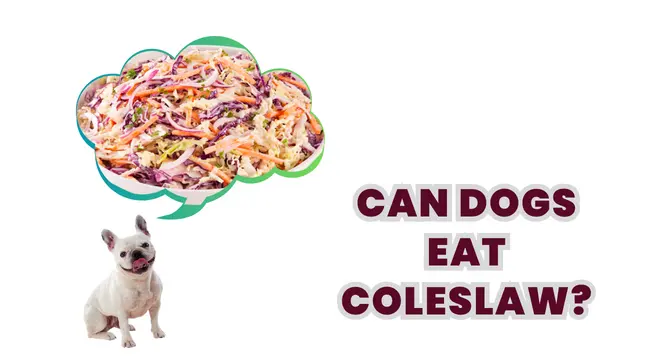
We all love sharing our life’s little joys with our furry friends, and sometimes that includes bits of our meals. It’s hard to resist those pleading eyes, but when it comes to foods like coleslaw, it’s important to step back and think about whether it’s safe for our dogs. Coleslaw is a staple at many of our gatherings, known for its crunchy cabbage and carrots all tossed in a creamy dressing. While sharing a spoonful might seem harmless, the ingredients and seasonings in coleslaw can be a different story for our canine pals. So, can dogs eat coleslaw without any worries, or are there hidden risks in this popular dish? This article dives into the details of coleslaw’s ingredients, highlights the potential hazards, and offers advice on how to safely include—or exclude—coleslaw from your dog’s diet. Let’s ensure your dog remains as healthy and joyful as the moments you share.
Can Dogs eEat Coleslaw?
No, dogs should generally not eat coleslaw due to potentially harmful ingredients.
Explanation: Coleslaw typically contains ingredients that can be unsafe for dogs, such as onions and garlic, which are toxic to them. Additionally, the dressing in coleslaw often contains mayonnaise, which is high in fats and can lead to pancreatitis in dogs if consumed in excess. Coleslaw can also have added sugar and salt, which aren’t healthy for dogs in large amounts. While plain cabbage and carrots are safe for dogs in moderation, the overall mixture and common ingredients in coleslaw make it unsuitable for dogs. If you wish to share some of the safe vegetables found in coleslaw with your dog, it’s best to prepare them plainly, without any added dressing or spices.
What is Coleslaw?
Coleslaw is a classic, chilled side dish beloved in many cultures, particularly popular at barbecues, picnics, and as a side in many restaurants. At its core, coleslaw consists of finely shredded raw cabbage mixed with a dressing. While the most traditional dressing is a creamy blend of mayonnaise, vinegar, sugar, and spices, the ingredients can vary widely to suit different tastes and dietary preferences.
The basic version of coleslaw usually includes carrots for a touch of sweetness and color, and sometimes onions for a bit of bite. However, the simplicity of coleslaw’s base allows for numerous variations. Some recipes might add ingredients like apple slices for a fruity crunch, bell peppers for vibrancy, or even raisins for a burst of sweetness.
Beyond the standard creamy style, there are other variations of coleslaw dressing that cater to different dietary needs and flavor profiles. For instance, vinegar-based dressings offer a tangier, lighter alternative to mayonnaise and are preferred for their longer shelf life at outdoor events. Some modern twists on coleslaw also incorporate ingredients like mustard, celery seeds, or fresh herbs to elevate the flavor.
Each variation of coleslaw brings its own unique twist to this versatile dish, making it a staple that never quite tastes the same from one kitchen to another.
Nutritional Content of Coleslaw
Coleslaw can vary significantly in its nutritional content depending on the ingredients and the type of dressing used. However, at its base, consisting mainly of cabbage and carrots, coleslaw offers a range of beneficial nutrients.
Basic Nutritional Components:
- Cabbage: This main ingredient is low in calories but high in dietary fiber, which can aid in digestion. It also provides vitamin K, vitamin C, and folate, making it an excellent choice for overall health.
- Carrots: Another core component, carrots are rich in beta-carotene, which is converted into vitamin A in the body. They offer vital nutrients that support vision, growth, and immune function.
- Mayonnaise: Often used in traditional coleslaw, mayonnaise adds a significant amount of fats—mostly unsaturated, which are healthier than saturated fats. It also contributes to the calorie count of the dish.
Ingredients Beneficial to Dogs:
- Cabbage and Carrots: Both are safe for dogs in moderation and can provide similar health benefits as they do for humans, such as improving digestion and providing vitamins. They should be given in small, manageable amounts to avoid digestive upset.
Potentially Harmful Ingredients:
- Onions and Garlic: Sometimes added for flavor, these are toxic to dogs and can cause serious health issues, including anemia.
- Excessive Mayonnaise: While not toxic, the high fat content in mayonnaise can lead to obesity and other related health issues in dogs, like pancreatitis, if consumed in large amounts.
- Sugar and Salt: Often added to enhance flavor, both can be harmful to dogs if ingested in large quantities. Salt can lead to sodium ion poisoning, and sugar can contribute to obesity and dental problems.
When considering sharing coleslaw with your dog, it’s crucial to adapt the recipe to be pet-friendly or offer only the plain vegetables in moderation. Always ensure that any human foods given to pets are free from harmful ingredients and fit into a well-balanced diet.
Related Post: Can dogs eat onions?
Potential Risks of Feeding Coleslaw to Dogs
While coleslaw can be a tasty treat for humans, several ingredients commonly found in this dish can pose significant health risks to dogs. Understanding these risks can help pet owners make safer dietary choices for their pets.
Toxic Ingredients:
- Onions and Garlic: These ingredients are often used to enhance the flavor of coleslaw. However, both onions and garlic contain compounds called thiosulfates, which are toxic to dogs. Even in small amounts, these can cause oxidative damage to red blood cells, leading to anemia. Symptoms of toxicity include weakness, lethargy, pale gums, and in severe cases, kidney damage.
- Excessive Mayonnaise: While mayonnaise itself is not toxic, its high fat content can be problematic for dogs. Consuming high-fat foods like mayonnaise can lead to pancreatitis in dogs, a serious condition that causes inflammation of the pancreas. Symptoms might include abdominal pain, vomiting, diarrhea, and decreased appetite.
High Sugar and Salt Content:
- Sugar: Coleslaw often contains sugar to balance the acidity of the dressing. For dogs, excessive sugar intake is not only unnecessary but can also lead to health issues such as obesity, dental problems, and even diabetes over time. It’s important to keep your dog’s diet low in simple sugars to avoid these health risks.
- Salt: Added to enhance the taste, salt, in large quantities, can be extremely harmful to dogs. High sodium intake in dogs can lead to sodium ion poisoning, with symptoms including vomiting, diarrhea, excessive thirst, and urination, which can further result in more serious conditions such as kidney damage or seizures.
Given these potential risks, it is advisable for dog owners to either significantly modify coleslaw (removing toxic and unhealthy ingredients) before offering it to their dogs or better yet, avoid feeding coleslaw to dogs altogether. Instead, consider providing safer, plain vegetables like shredded cabbage and carrots in moderation, which can be beneficial without the associated risks of the traditional coleslaw recipe.
Related Post: Can dogs eat garlic?
Safe Ingredients in Coleslaw for Dogs
While traditional coleslaw contains ingredients that can be harmful to dogs, there are several components that can be safely included in a dog-friendly version of this popular dish. Knowing which ingredients are safe and how to prepare them can help pet owners provide a nutritious and enjoyable treat for their canine companions.
Safe Ingredients:
- Cabbage: This is a main ingredient in coleslaw and is safe for dogs in moderation. Cabbage is rich in fiber and antioxidants, which can benefit a dog’s digestion and overall health. It should be given in small amounts as excessive cabbage can cause gas in dogs.
- Carrots: These are often included in coleslaw for added color and sweetness. Carrots are excellent for dogs as they provide beta-carotene, vitamins, and fiber. They can be served raw or lightly steamed to help maintain their nutritional benefits.
- Apples (without seeds): Sometimes added for a sweet crunch, apples are safe for dogs if the core and seeds are removed, as these parts contain cyanide which is toxic to dogs.
Preparation Tips:
- Wash Thoroughly: Always wash all vegetables thoroughly to remove any pesticides or contaminants that might be present on the surface.
- Chop Appropriately: Cut ingredients into small, manageable pieces to prevent choking and to make it easier for dogs to digest.
- Cook Lightly (Optional): While raw vegetables are generally safe, light steaming can make them easier to digest and can enhance their natural flavors without the need for added fats or seasonings.
- Avoid Harmful Additives: Do not use onions, garlic, or excessive mayonnaise. Also, steer clear of seasoning with salt and sugar. If dressing is desired, a small amount of plain yogurt or pureed pumpkin can be used as a healthy alternative.
- Introduce Gradually: When introducing new foods to your dog’s diet, start with small quantities to see how they react to it, ensuring there are no adverse effects on their digestion or health.
By carefully selecting and preparing these ingredients, you can create a version of coleslaw that is not only safe but also beneficial for your dog, allowing them to enjoy a tasty treat without the risks associated with traditional coleslaw recipes.
How to Safely Introduce Coleslaw Ingredients to Your Dog’s Diet
Introducing new foods to your dog should be done cautiously to avoid digestive upset and to monitor for any allergic reactions. Here’s how you can safely introduce coleslaw ingredients:
Guidelines for Introducing New Foods:
- Start Small: Begin with a small amount of the new food mixed into your dog’s regular diet. This helps your dog adjust to the new taste and texture.
- Observe: Watch for any signs of gastrointestinal distress or allergic reactions such as itching, excessive gas, vomiting, or diarrhea. If any of these occur, discontinue the new food and consult your veterinarian.
- Incrementally Increase: If your dog tolerates the new food well, gradually increase the portion over several days, allowing their digestive system to adapt.
Recommended Portion Sizes and Frequency:
- Portion Size: Treats and new foods like safe coleslaw ingredients should not make up more than 10% of your dog’s total daily calorie intake. A few tablespoons, depending on the size of the dog, is a good starting point.
- Frequency: Introduce new foods once every few days. This spacing gives enough time to identify any adverse reactions and ensures a varied diet.
Healthy Alternatives to Coleslaw for Dogs
Instead of traditional coleslaw, which may contain harmful ingredients, consider these healthy alternatives that are safe and nutritious for dogs:
Suggestions for Dog-Friendly Vegetable Mixes:
- A mix of shredded carrots, chopped apples (seedless), and a sprinkle of celery can mimic the texture and crunch of coleslaw without the risky ingredients.
- Green beans, peas, and a touch of plain pumpkin puree can offer a nutritious, fiber-rich alternative.
Recipes for Homemade Dog-Safe “Coleslaw”:
- Basic Veggie Slaw: Combine finely shredded cabbage, peeled and shredded carrots, and a spoonful of plain yogurt for dressing. Mix well and serve in small quantities.
- Apple Carrot Crunch: Mix grated carrots and apple slices (without seeds) with a dollop of pureed pumpkin for a sweet and crunchy treat.
Conclusion
In conclusion, while the tempting crunch of coleslaw might make it a favored side dish at human tables, not all its ingredients are safe for our canine companions. We’ve explored which elements of coleslaw can be included in a dog-friendly version and outlined how to introduce these safely into your dog’s diet. Additionally, we provided some creative and healthy alternatives that ensure pets can enjoy a similar experience without any risks. Remember, the key to a healthy diet for your dog lies in understanding and carefully selecting what they eat. Always prioritize their health by choosing safe, nutritious options and consult with your veterinarian when introducing any new foods. By being mindful of these guidelines, you can ensure that both you and your pet enjoy meal times happily and healthily.



